Reviewer's Note: The Dear 123 was provided for review by NaitHawk. Please see their CPFMP Manufacturer's thread for more info.
Warning: pic heavy, as usual.
Manufacturer's specifications, condensed from their CPFMP thread:
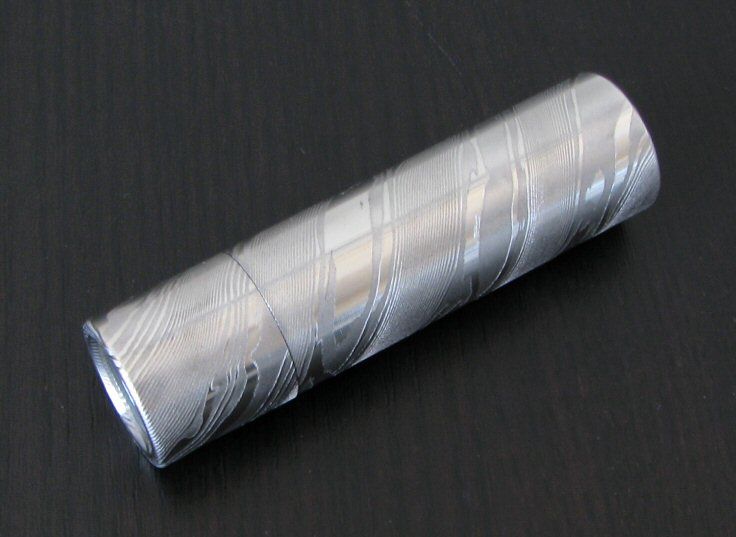
First a bit of background – NaitHawk describes this light as a "pattern Damascus steel flashlight." Damascus steel refers to a form of folded-over, hot-forged steel that was used in Middle Eastern sword-making during the Middle Ages. Famed for its strength and sharpness, the original recipes and methods of Damascus steel production are believed to have been lost several centuries ago.
FYI, here is a close-up of an actual 13th century Damascus steel sword that I photographed in a Middle Eastern museum in Qatar:
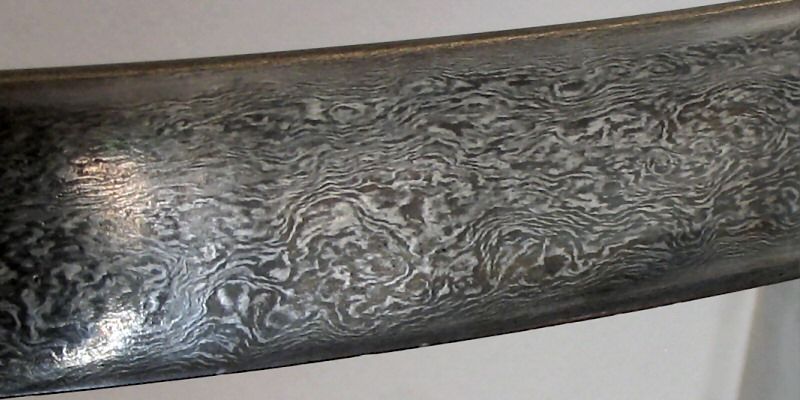
Of interest today, a product with a somewhat similar appearance can be produced through a method called "pattern welding." Widely used in custom knife making, pattern welding involves welding together two or more types of steels with different nickel and/or carbon content, in order to capture their respective properties and advantages in the final product.
This method can produce alternating dark and light stripes, similar to what you see in Damascus steel. As such, you will sometimes see pattern-welded steel called Damascus steel today – although to be more accurate, this should probably be referred to as "Damascened" steel, since there is debate and controversy surrounding the original Damascus steel production methods (e.g. see the Wikipedia entry for an example of how confused discussions on this material can be).
Suffice it to say, the modern pattern welded steel it should be pretty strong – and definitely pretty to look at. :kiss:
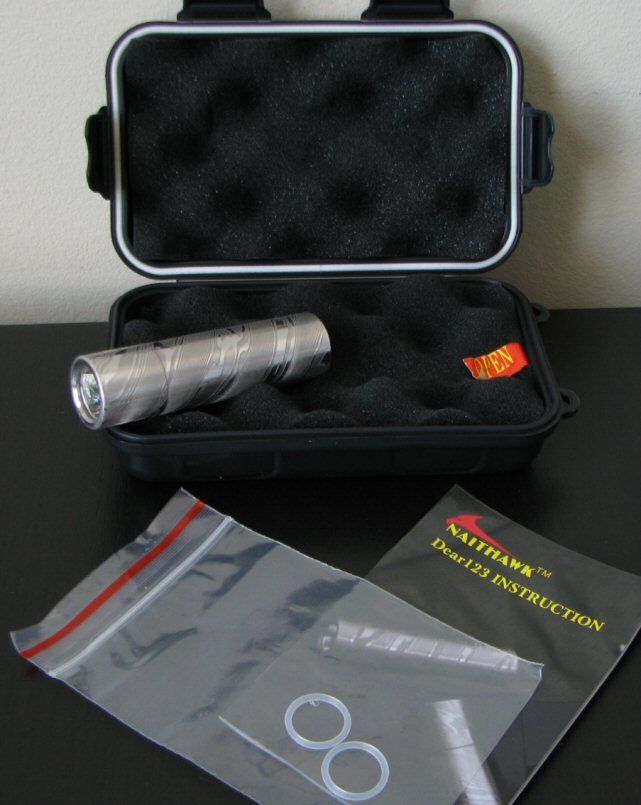
The light comes in a good quality re-sealable plastic carrying container, with foam inserts to securely hold the light. Under the bottom foam piece you will find the extra o-rings and instruction manual.
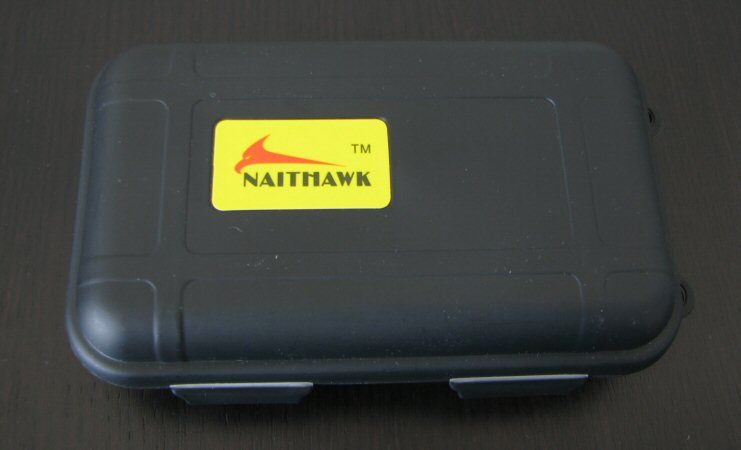
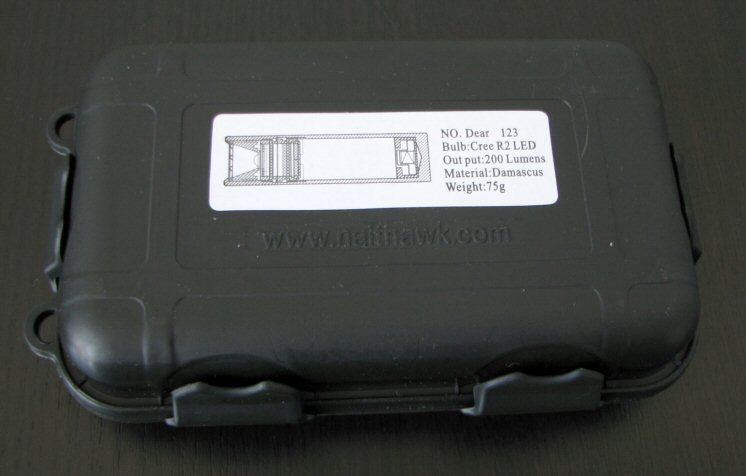

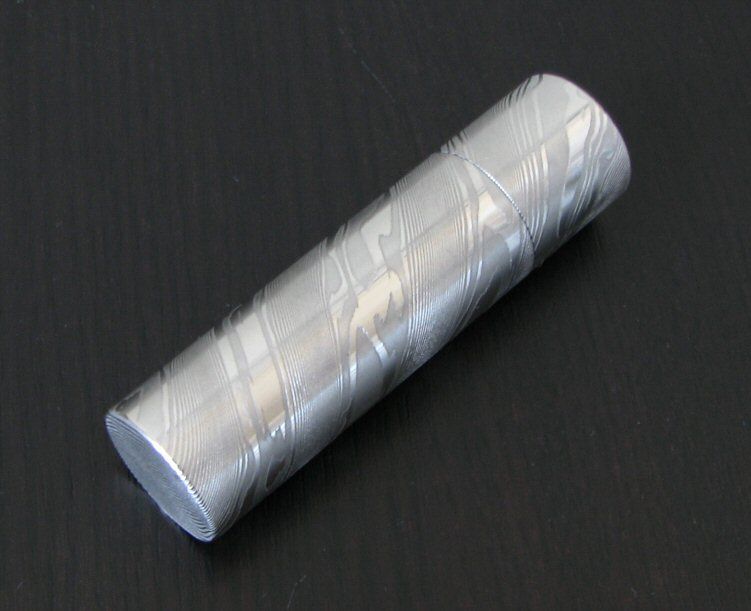
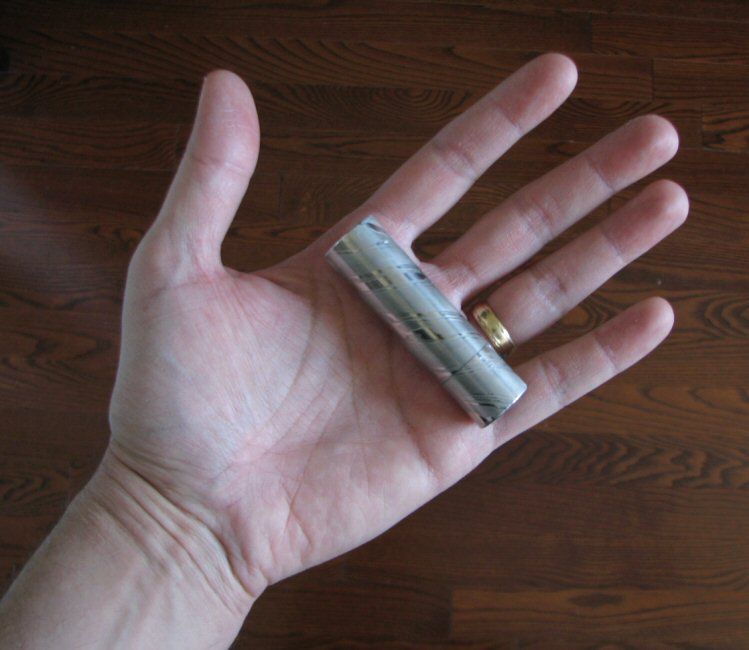
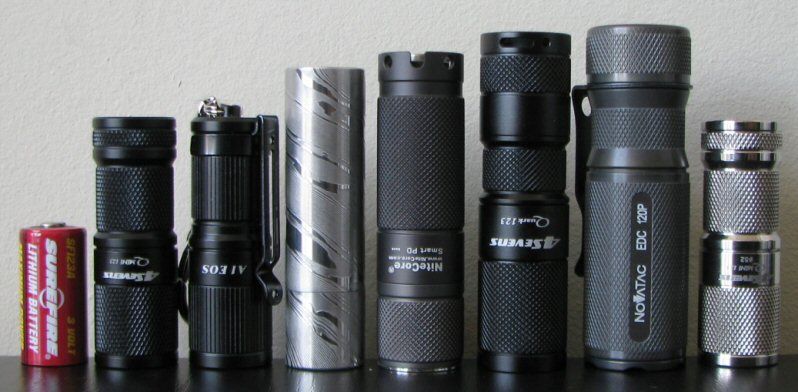
From left to right: Surefire CR123A, 4Sevens MiNi 123, ITP A1, NaitHawk Dear 123, Nitecore EX10, 4Sevens Quark 123, Novatac 120P, 4Sevens MiNi Titanium
Dear 123: Weight 69.7g, Length 72.9mm x Width 19.5mm (bezel)
Dimensions are reasonable for this sort of twisty light. Weight is higher than typical, due to the steel construction.
Fit and finish are very unique - the pattern welded steel has interesting llight/dark stripes running throughout the material. oo: Although you can feel the difference by touch, the effect is subtle (except for perhaps the ends of the light where it is more noticeable). Note that this is indeed true pattern welding and not just a surface modification – if you look at the screw thread shot below, you can see the pattern continues throughout.
oo: Although you can feel the difference by touch, the effect is subtle (except for perhaps the ends of the light where it is more noticeable). Note that this is indeed true pattern welding and not just a surface modification – if you look at the screw thread shot below, you can see the pattern continues throughout.
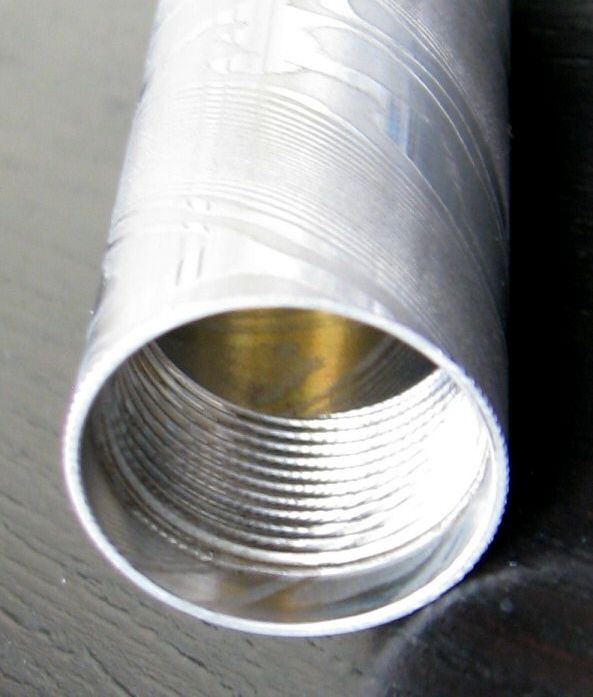
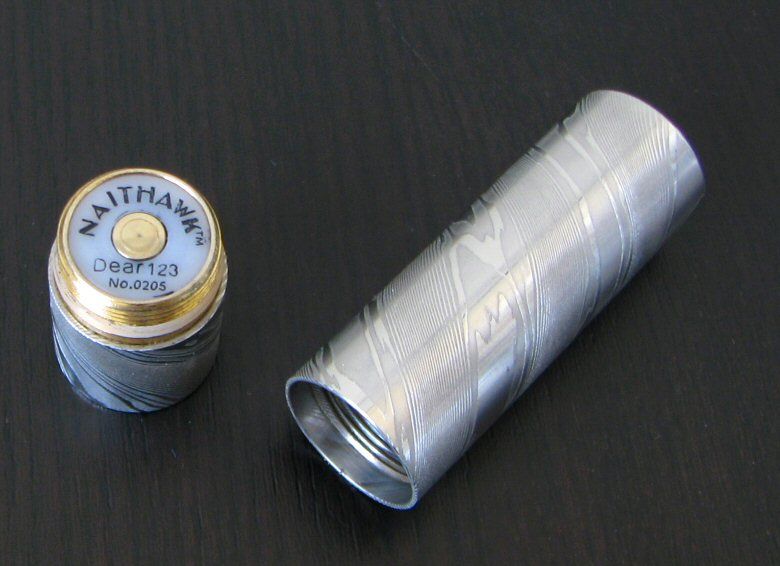
The head appears to be sitting within a brass heatsink, which directly screws into the body/battery tube. Some of the brass heatsink is visible in the gap between the head and body.
Internally, the light has what appears to be a brass base with a short post at the negative battery terminal. However, this is just a contact cover - underneath that center post is a spring, which will help prevent this light from crushing your cells. :thumbsup:
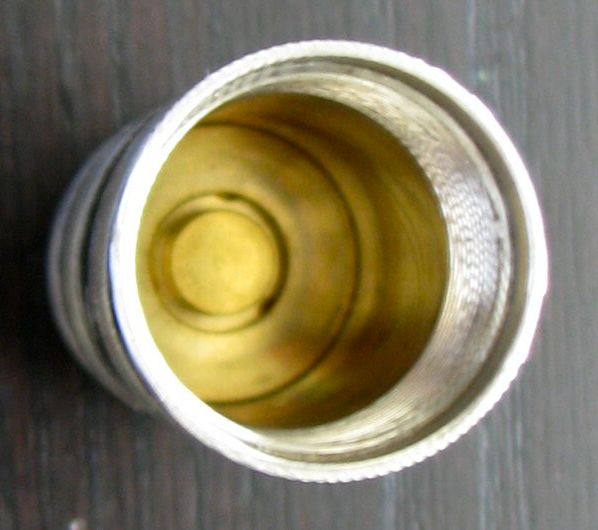
The light can tailstand, although there is unfortunately no attachment point for a lanyard anywhere.
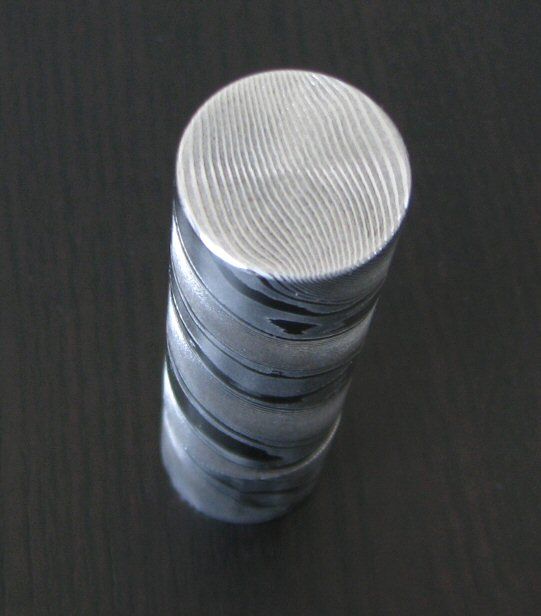
Surprising for a new light, the emitter used is the standard Cree XR-E (R2 output bin, WC tint bin). Reflector is reasonably deep, and heavily textured.
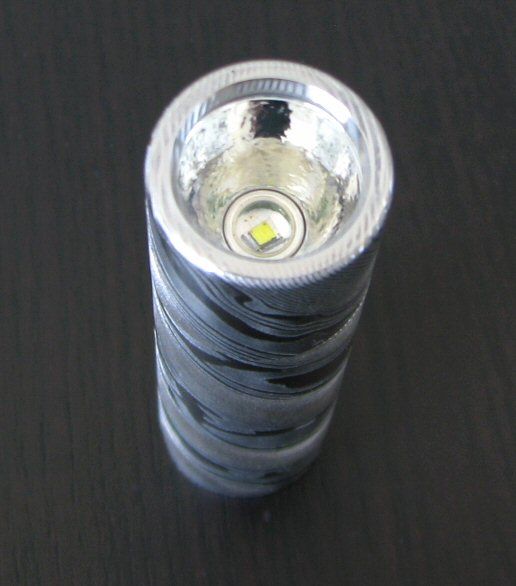
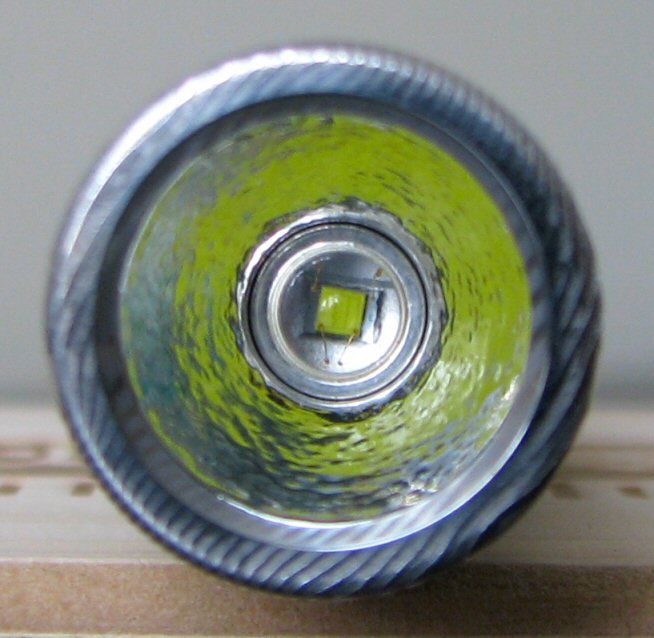
And now for the requisite white wall hunting … all lights are on Max with on AW RCR, about 0.5 meters from a white wall.
… all lights are on Max with on AW RCR, about 0.5 meters from a white wall.
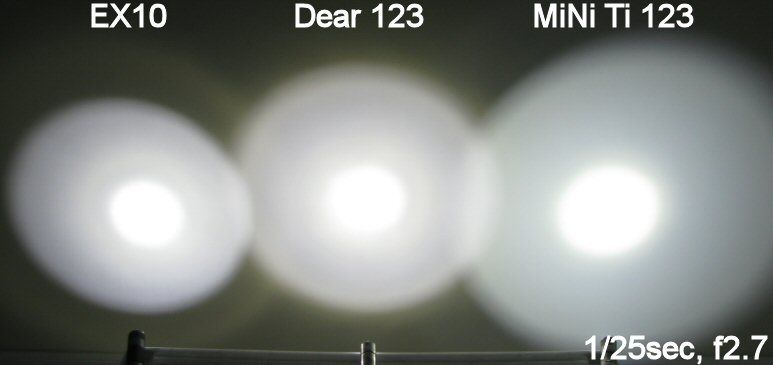
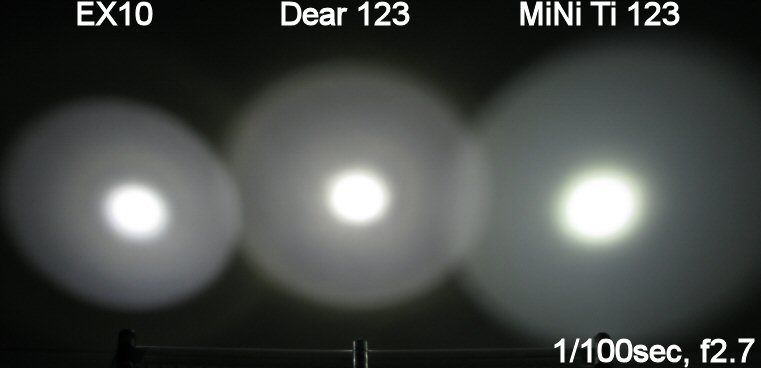
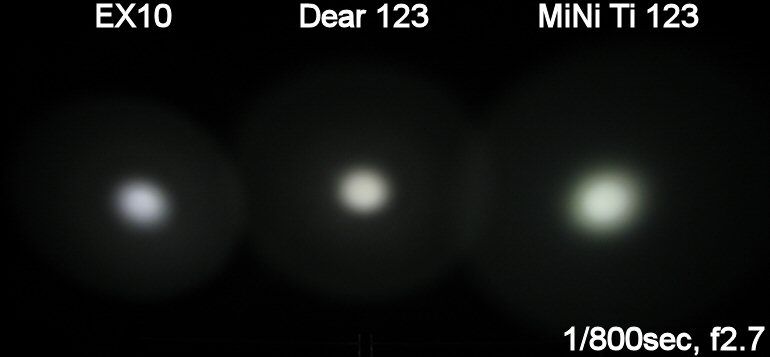
Beam pattern is fairly good for a Cree XR-E, with only a minimal dark rink around the hospot (i.e. similar to Cree XR-E Q5 EX10 above). Not sure why NaitHawk isn't using the more common XP-E/XP-G emitter, but XR-E does typically produce greater throw. :shrug:
Tint is very good on my sample, so the WC tint bin spec is believable. For those of you not familiar with tint bins, please see my Colour tint comparison and the summary LED tint charts found here.
User Interface
The Dear 123 has three output modes: Lo, Hi and Beacon.
Like a number of twisty lights, the Dear 123 is off when the head is fully tightened against the body. To activate the light, simply loosen the head slightly. The initial output mode is Lo, and the light has mode memory (i.e. leave it off for awhile, it will come back on at the last mode used).
To advance to the next output mode, do a tighten-loosen twist from on (i.e. on-off-on) within a sec or so. The next mode will be Hi. Do a tighten-loosen twist again and you will get the Beacon mode. Modes repeat in the Lo – Hi – Beacon sequence.
The Beacon mode is quite interesting – it is basically a 1 flash per second strobe (actually, more like 0.9 Hz):
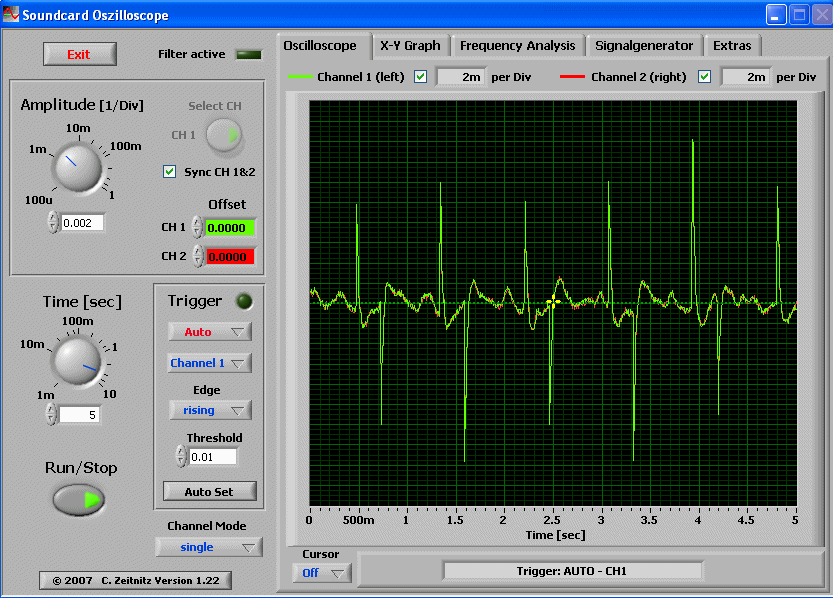
Although NaitHawk claims current-controlled output, I was able to detect a re-occuring signal at 4.2kHz when on Lo. This would seem to suggest PWM is used for Lo, but the frequency is high enough that you can't detect it by eye.
Testing Method: All my output numbers are relative for my home-made light box setup, a la Quickbeam's flashlightreviews.com method. You can directly compare all my relative output values from different reviews - i.e. an output value of "10" in one graph is the same as "10" in another. All runtimes are done under a cooling fan, except for the extended run Lo/Min modes (i.e. >12 hours) which are done without cooling.
Throw values are the square-root of lux measurements taken at 1 meter from the lens, using a light meter.
Throw/Output Summary Chart:
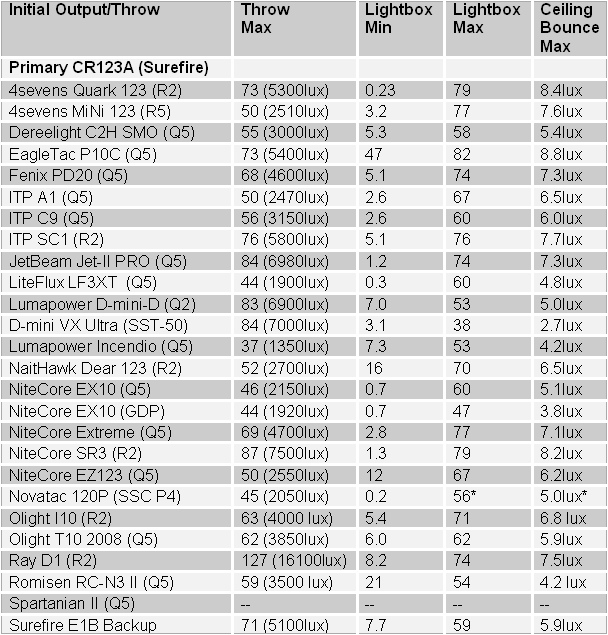
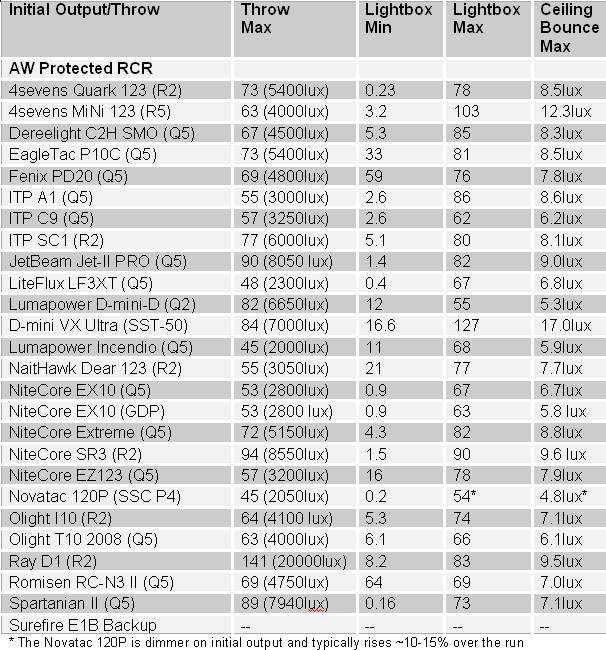
Max Output and throw are roughly what I would have expected for a XR-E-based light. It is not a barn burner, but it is reasonable for a light this size.
Lo mode is similar to other 2-stage lights.
Output/Runtime Comparison:
Note: Effective January 2010, all CR123A runtimes are now performed solely on Titanium Innovations batteries sponsored by BatteryJunction.com. You can compare the generally excellent performance of these CR123A cells relative to the Duracell/Surefire cells used in all my earlier reviews here. I have marked all the new runtimes of lights with Titanium Innovations CR123As on the graphs with an "*".
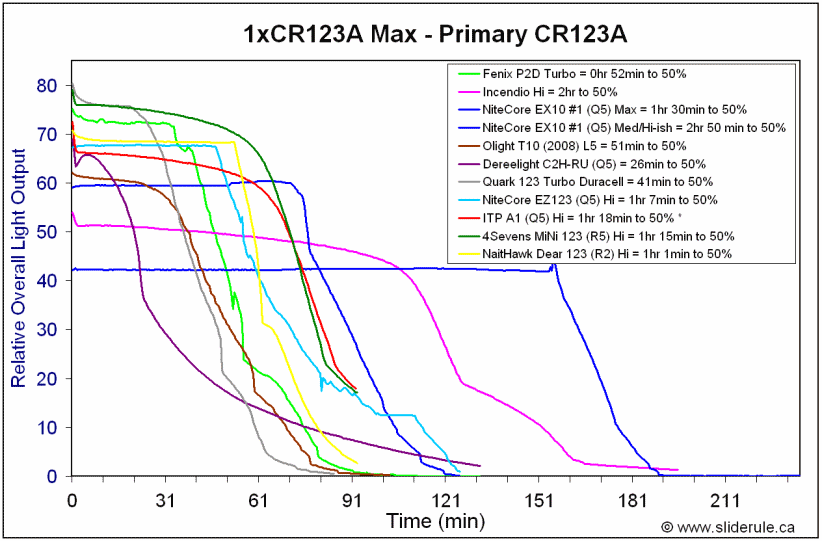
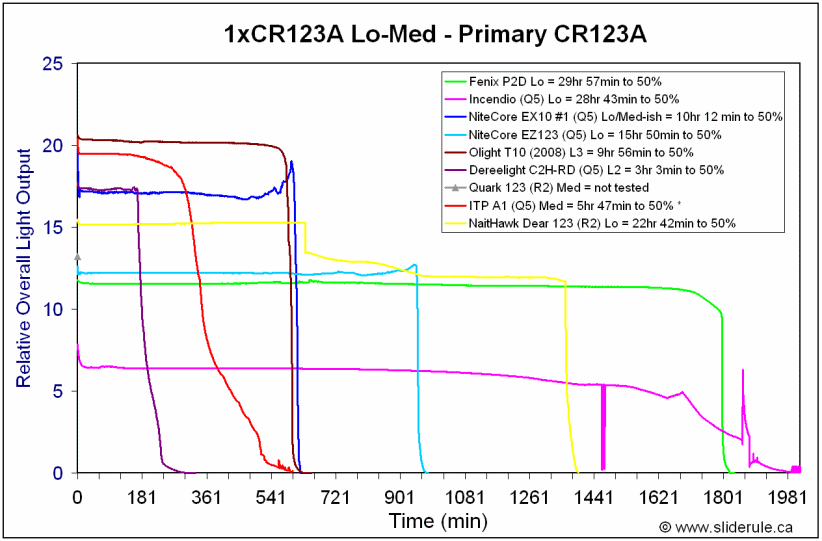
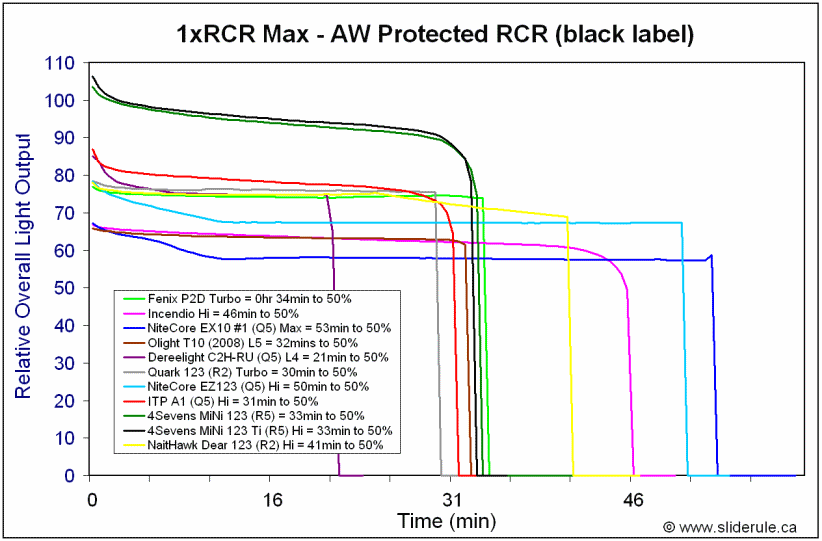
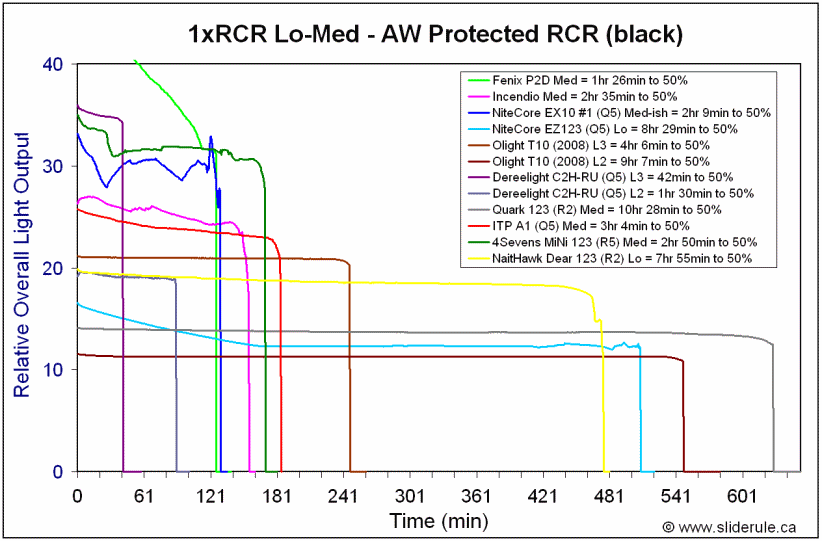
Performance on Hi is pretty much as I would have expected. Efficiency seems rather good on the Lo output mode (especially on RCR), relative to the competition.
Potential Issues
Battery tube internal diameter is narrow – most of my protected AW RCR wouldn't fit pass the screw threads. Since the light has no tailcap, if you a force a battery in, you may not be able to get it out.
Since the light has no tailcap, if you a force a battery in, you may not be able to get it out.
Steel is not as good a conductor of heat as aluminum, but the brass heatsink should help in this case.
UPDATE 4/13/2010: I originally thought the light used a solid post for the negative terminal, but I see now that is is indeed spring-mounted. This should remove the potential risk of crushing a battery.
There is no wrist/lanyard strap attachment point.
Preliminary Observations
The Dear 123 is certainly one of the more distinctive lights I've reviewed in the 1xCR123A class. oo:
oo:
Although I am not generally a fan of stainless steel construction, the pattern welding technique used here produces a very unique looking product (and one that should be quite durable). The very solid build - including brass internal components and heatsink – inspires further confidence that this light is built to last.
User interface is reasonable for a general-purpose twisty light (i.e. Lo, Hi, Beacon), and the efficiency is very good for a two-stage light. Personally, I rather like the beacon mode with its slow 0.9 Hz signal (i.e. just under once per second). Very useful for signaling purposes (I can't see myself ever using a tactical strobe – I'm more likely to disorient myself if I were to try ).
).
The emitter choice is interesting – most makers have switched to the smaller profile XP-E/XP-Gs (which are also capable of higher outputs). Not sure why NaitHawk has chosen to stick with the original XR-E. :thinking: But they have gone for the highest XR-E output bin (R2), premium cool white tint (WC), and a heavily textured reflector to reduce rings.
All in all, the Dear 123 is a sturdy and attractive light from a new manufacturer. Although clearly marketed for those looking for a bit of "bling" (and willing to pay for it), the user interface is consistent with a number of popular general purpose lights.
Warning: pic heavy, as usual.
Manufacturer's specifications, condensed from their CPFMP thread:
- LED: Cree XR-E R2 (WC) LED
- Max Output: 200 lumens
- Mode: Low- - High - Beacon Strobe
- Output&Runtime:
- 3V Lithium batteries: Maximum output is 180 Lumens about (118 minutes), Minimum output is 16 Lumens about (28 hours), Beacon Strobe 1 Hz (8 hours)
- 3.6V Lithium batteries: Maximum output is 200 Lumens for about (75minutes), Minimum output is 22 Lumens for about (16 hours), Beacon Strobe 1 Hz (3.5 hours)
- Switch: Tighten off - unscrew to open
- Battery: CR123A or 16340 Lithium batteries
- Circuit : Constant current circuit
- Material: Damascus pattern-welded steel
- Waterproof: to IPX-8 standard
- Surface Treatment: polished or drawn wire treatment
- Lens: Double-sided coating, the light transmission rate of 97%
- Reflector: High-quality aluminum half orange peel reflector
- Dimension: 74 mm(length) × 19.5mm (diameter)
- Weight: 75g (without battery)
- Accessories: O-Rings,Operator's Manual, Multi-function Waterproof Box
- MSRP $239

First a bit of background – NaitHawk describes this light as a "pattern Damascus steel flashlight." Damascus steel refers to a form of folded-over, hot-forged steel that was used in Middle Eastern sword-making during the Middle Ages. Famed for its strength and sharpness, the original recipes and methods of Damascus steel production are believed to have been lost several centuries ago.
FYI, here is a close-up of an actual 13th century Damascus steel sword that I photographed in a Middle Eastern museum in Qatar:

Of interest today, a product with a somewhat similar appearance can be produced through a method called "pattern welding." Widely used in custom knife making, pattern welding involves welding together two or more types of steels with different nickel and/or carbon content, in order to capture their respective properties and advantages in the final product.
This method can produce alternating dark and light stripes, similar to what you see in Damascus steel. As such, you will sometimes see pattern-welded steel called Damascus steel today – although to be more accurate, this should probably be referred to as "Damascened" steel, since there is debate and controversy surrounding the original Damascus steel production methods (e.g. see the Wikipedia entry for an example of how confused discussions on this material can be).
Suffice it to say, the modern pattern welded steel it should be pretty strong – and definitely pretty to look at. :kiss:

The light comes in a good quality re-sealable plastic carrying container, with foam inserts to securely hold the light. Under the bottom foam piece you will find the extra o-rings and instruction manual.






From left to right: Surefire CR123A, 4Sevens MiNi 123, ITP A1, NaitHawk Dear 123, Nitecore EX10, 4Sevens Quark 123, Novatac 120P, 4Sevens MiNi Titanium
Dear 123: Weight 69.7g, Length 72.9mm x Width 19.5mm (bezel)
Dimensions are reasonable for this sort of twisty light. Weight is higher than typical, due to the steel construction.
Fit and finish are very unique - the pattern welded steel has interesting llight/dark stripes running throughout the material.


The head appears to be sitting within a brass heatsink, which directly screws into the body/battery tube. Some of the brass heatsink is visible in the gap between the head and body.
Internally, the light has what appears to be a brass base with a short post at the negative battery terminal. However, this is just a contact cover - underneath that center post is a spring, which will help prevent this light from crushing your cells. :thumbsup:

The light can tailstand, although there is unfortunately no attachment point for a lanyard anywhere.

Surprising for a new light, the emitter used is the standard Cree XR-E (R2 output bin, WC tint bin). Reflector is reasonably deep, and heavily textured.


And now for the requisite white wall hunting



Beam pattern is fairly good for a Cree XR-E, with only a minimal dark rink around the hospot (i.e. similar to Cree XR-E Q5 EX10 above). Not sure why NaitHawk isn't using the more common XP-E/XP-G emitter, but XR-E does typically produce greater throw. :shrug:
Tint is very good on my sample, so the WC tint bin spec is believable. For those of you not familiar with tint bins, please see my Colour tint comparison and the summary LED tint charts found here.
User Interface
The Dear 123 has three output modes: Lo, Hi and Beacon.
Like a number of twisty lights, the Dear 123 is off when the head is fully tightened against the body. To activate the light, simply loosen the head slightly. The initial output mode is Lo, and the light has mode memory (i.e. leave it off for awhile, it will come back on at the last mode used).
To advance to the next output mode, do a tighten-loosen twist from on (i.e. on-off-on) within a sec or so. The next mode will be Hi. Do a tighten-loosen twist again and you will get the Beacon mode. Modes repeat in the Lo – Hi – Beacon sequence.
The Beacon mode is quite interesting – it is basically a 1 flash per second strobe (actually, more like 0.9 Hz):
Although NaitHawk claims current-controlled output, I was able to detect a re-occuring signal at 4.2kHz when on Lo. This would seem to suggest PWM is used for Lo, but the frequency is high enough that you can't detect it by eye.
Testing Method: All my output numbers are relative for my home-made light box setup, a la Quickbeam's flashlightreviews.com method. You can directly compare all my relative output values from different reviews - i.e. an output value of "10" in one graph is the same as "10" in another. All runtimes are done under a cooling fan, except for the extended run Lo/Min modes (i.e. >12 hours) which are done without cooling.
Throw values are the square-root of lux measurements taken at 1 meter from the lens, using a light meter.
Throw/Output Summary Chart:


Max Output and throw are roughly what I would have expected for a XR-E-based light. It is not a barn burner, but it is reasonable for a light this size.
Lo mode is similar to other 2-stage lights.
Output/Runtime Comparison:
Note: Effective January 2010, all CR123A runtimes are now performed solely on Titanium Innovations batteries sponsored by BatteryJunction.com. You can compare the generally excellent performance of these CR123A cells relative to the Duracell/Surefire cells used in all my earlier reviews here. I have marked all the new runtimes of lights with Titanium Innovations CR123As on the graphs with an "*".




Performance on Hi is pretty much as I would have expected. Efficiency seems rather good on the Lo output mode (especially on RCR), relative to the competition.
Potential Issues
Battery tube internal diameter is narrow – most of my protected AW RCR wouldn't fit pass the screw threads.
 Since the light has no tailcap, if you a force a battery in, you may not be able to get it out.
Since the light has no tailcap, if you a force a battery in, you may not be able to get it out.Steel is not as good a conductor of heat as aluminum, but the brass heatsink should help in this case.
UPDATE 4/13/2010: I originally thought the light used a solid post for the negative terminal, but I see now that is is indeed spring-mounted. This should remove the potential risk of crushing a battery.
There is no wrist/lanyard strap attachment point.
Preliminary Observations
The Dear 123 is certainly one of the more distinctive lights I've reviewed in the 1xCR123A class.
Although I am not generally a fan of stainless steel construction, the pattern welding technique used here produces a very unique looking product (and one that should be quite durable). The very solid build - including brass internal components and heatsink – inspires further confidence that this light is built to last.
User interface is reasonable for a general-purpose twisty light (i.e. Lo, Hi, Beacon), and the efficiency is very good for a two-stage light. Personally, I rather like the beacon mode with its slow 0.9 Hz signal (i.e. just under once per second). Very useful for signaling purposes (I can't see myself ever using a tactical strobe – I'm more likely to disorient myself if I were to try
The emitter choice is interesting – most makers have switched to the smaller profile XP-E/XP-Gs (which are also capable of higher outputs). Not sure why NaitHawk has chosen to stick with the original XR-E. :thinking: But they have gone for the highest XR-E output bin (R2), premium cool white tint (WC), and a heavily textured reflector to reduce rings.
All in all, the Dear 123 is a sturdy and attractive light from a new manufacturer. Although clearly marketed for those looking for a bit of "bling" (and willing to pay for it), the user interface is consistent with a number of popular general purpose lights.
Last edited:


 for no apparent reason. I will say that I received amazing support from Naithawk (despite their name choice!). Susie from Naithawk had a new unit to me within days that I have been 100% satisfied with. (I still have to return the defective unit, thanks Susie!)
for no apparent reason. I will say that I received amazing support from Naithawk (despite their name choice!). Susie from Naithawk had a new unit to me within days that I have been 100% satisfied with. (I still have to return the defective unit, thanks Susie!) I have just updated the review.
I have just updated the review.